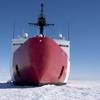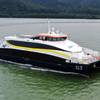While shipbuilding giants such as Hyundai, Samsung and Daewoo are devouring orders for ultra-large vessels with unmatched technology, midsized shipbuilders are expanding facilities and revving up exports to beat Chinese and Japanese counterparts.
Seven Korean shipbuilders managed to dominate the world's top posts in terms of order backlogs thanks to years of technological development and lavish investment on facility expansion.
Despite the drop in containership demand this year, they are still flourishing as high oil prices led to increased orders for liquefied natural gas carriers - the most profitable freighters - and costly offshore engineering facilities to drill oil from sea beds. Many industry observers expect Korea's Big Seven to be leaders in these high value-added areas for a number of years. Meanwhile, about another 10 smaller shipyards are following their footsteps to lead the global market for midsized ships."
The amount of midsized ship orders received by Japan also continued to drop from 3.94 million tons in 2003 to 2.13 million tons in 2005 to be finally beaten by Korea (2.63 million tons).
As for China, midsized ships take up 70 percent (about 3 million tons) of total orders and some 400 midsized shipyards were operating as of 2003.
Bulk carriers of less than 50,000 dead-weight tonnage, tankers of less than 30,000 dead-weight tonnage and containerships sized 2,000 TEU (20-foot equivalent unit) or smaller are classified as midsized vessels.
Most of the midsized shipbuilders in Korea began making new vessels after engaging in repairs or parts supply.
With accumulated know-how on manufacturing blocks and other shipbuilding equipment, they shifted to building their own ships. Some acquired existing shipyards.
Companies such as SLS Shipbuilding (former Shin-a), Daesun Shipbuilding and Nokbong Shipbuilding have more than 10 years of experience. Others including SPP Shipbuilding or Daehan Shipbuilding are vigorously expanding their dockyards after a market debut of just two to three years ago.
Their major products are chemical and oil tankers whereas their Japanese counterparts build more bulk and gas carriers. The Chinese focus mainly on bulk carriers and containerships.
According to London-based Clarkson Plc., Korea had an order backlog of 5.96 million compensated gross tons for midsized ships as of March, enough to keep current dockyards busy for the next three years. Eighty-three percent of the orders were chemical and oil tankers.
Clarkson projects the demand for oil tankers and chemical tankers to grow 2.5 percent and 3.3 percent every year until 2025 on swelling oil transportation needs.
However, their profitability has not been as steady as their sales. Yang notes that the combined sales of SLS and Daesun soared at an average rate of 26.7 percent annually for the past five years but their operating profit took a downturn in 2002 due to low ship prices. The profit decline resulted in an operating loss of 33 billion won last year and as the domestic currency gained against the dollar.
(www.koreaherald.co.kr)
Featured videos

Inside the Electrified Truckable Tug

Tracking Foreign Vessels Working in the U.S. Jones Act Market

Inmarsat Enhances Service to Drive Digitalization
Subscribe for
Maritime Reporter E-News
Maritime Reporter E-News is the maritime industry's largest circulation and most authoritative ENews Service, delivered to your Email five times per week









